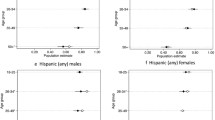Abstract
Understanding changes in substance use in a small population state is challenging. Many national datasets restrict data to reduce the probability of identifying persons. Alaska is a small population state (731,000 residents) with a large geographic region (25% the size of the lower 48), a diverse population, and highly variable seasons, with fewer than 10% of the state being road accessible. Given the uniqueness of Alaska, this project sought to understand what could be learned about addiction and its relationships with unemployment and median income in Alaska. National Survey on Drug Use and Health, State and Small Area Estimates (1999–2020) data were analyzed to measure prevalence changes. Outcome prevalence were independently correlated with median income and annual unemployment rate as the annual collection periods varied. Analyses were limited to simple bivariate analyses due to the data restrictions. Median income was found to have stronger correlational relationships and significant relationships with more negative outcomes compared to unemployment. While annual unemployment rates had statistically significant relationships with substance use outcomes, negative mental health outcomes appeared more related to unemployment than median income. Alcohol use in the past month, cigarette and tobacco use, and pain reliever misuse declined while binge drinking in the past month and illicit drug use increased. More people reported depression, serious mental illness, and suicidal ideation and planning over time peaking in the last year of data collection. While NSDUH data provide some idea of the changes in drug use over time, their effectiveness in Alaska is unknown. Many data sources claim they are nationally representative, but these statements cannot be objectively measured. We will use these outcomes and data as a baseline for future studies where we will explore state specific data sources.
Similar content being viewed by others
Data Availability
The data used are available for download through the National Drug Use and Health Survey website.
References
Glowacki, E. M., Glowacki, J. B., & Wilcox, G. B. (2018). A text-mining analysis of the public’s reactions to the opioid crisis. Substance Abuse, 39(2), 129–133.
Saloner, B., McGinty, E. E., Beletsky, L., Bluthenthal, R., Beyrer, C., Botticelli, M., & Sherman, S. G. (2018). A public health strategy for the opioid crisis. Public Health Report, 133(1), 24s–34s.
Lytle, A., Apriceno, M., & Kowal, M. (2020). How intergroup contact and demographic factors influence attitudes toward and perceptions of addiction. Addiction Research & Theory, 28(5), 425–432.
Matthews, S., Dwyer, R., & Snoek, A. (2017). Stigma and self-stigma in addiction. Journal of Bioethical Inquiry, 14(2), 275–286.
Whitesock, D., Zhao, J., Goettsch, K., & Hanson, J. (2018). Validating a survey for addiction wellness: The recovery capital index. South Dakota Medicine., 71(5), 202–212.
The Economic Costs of Drug Misuse in Alaska 2019 Update. Anchorage: The McDowell Group; 2019
Key Substance Use and Mental Health Indicators in the United States: Results from the 2019 National Survey on Drug Use and Health. Rockville, MD: Substance Abuse and Mental Health Services Administration; 2020. Contract No.: HHS Publication No. PEP20–07–01–001, NSDUH Series H-55
Fatal Injury and Violence Data. US Centers for Disease Control and Prevention; 1999–2020
Economic Cost of Substance Abuse Disorder in the United States, 2019. Recovery Centers of America; 2020
Schauer, G. L., Dilley, J. A., Roehler, D. R., Sheehy, T. J., Filley, J. R., Broschart, S. C., et al. (2021). Cannabis sales increases during COVID-19: Findings from Alaska, Colorado, Oregon, and Washington. International Journal of Drug Policy., 98, 103384.
Health, United States, 2019: Table 020. Hyatville, MD: National Center for Health Statistics; 2019.
Cerdá, M., Mauro, C., Hamilton, A., Levy, N. S., Santaella-Tenorio, J., Hasin, D., et al. (2020). Association between recreational marijuana legalization in the United States and changes in marijuana use and cannabis use disorder from 2008 to 2016. JAMA Psychiatry, 77(2), 165–171.
Swift, S. L., Elfassy, T., Bailey, Z., Florez, H., Feaster, D. J., Calonico, S., et al. (2020). Association of negative financial shocks during the great recession with depressive symptoms and substance use in the USA: The CARDIA study. Journal of Epidemiology and Community Health, 74(12), 995–1001.
Center for Behavioral Health Statistics and Quality. (2021). 1999 to 2019 National Surveys on Drug Use and Health (NSDUHs) Small Area Estimation Dataset: State Small Area Estimates, by Survey Year, Outcome, State, and Age Group. NSDUH methodological report. Rockville, MD2021
State of Alaska Population Estimates 2021. Anchorage: State of Alaska Department of Labor and Workforce Development, Research and Analysis; 2022
R Core Team (2021). R: A language and environment for statistical computing. R Foundation for Statistical Computing, Vienna Austria
Jebb, A. T., Tay, L., Diener, E., & Oishi, S. (2018). Happiness, income satiation and turning points around the world. Nature Human Behaviour., 2(1), 33–38.
World Health Statistics 2021. Geneva: World Health Organization; 2021.
Funding
We received no funding to support this project.
Author information
Authors and Affiliations
Contributions
RDP concept, analyses, and manuscript draft. LL, MA, JM review and edit of manuscript draft, tables, and data presentation.
Corresponding author
Ethics declarations
Conflict of interest
We have no conflicts of interest nor competing interests to report.
Informed Consent
As a secondary data review there were no participant consents. There are no images nor data requiring consent.
Research Involving Human and Animal Participant
This project was determined to be non-human subjects research by the institutional review board based on 45 CFR 46 and the use of deidentified, publicly available data.
Additional information
Publisher's Note
Springer Nature remains neutral with regard to jurisdictional claims in published maps and institutional affiliations.
Rights and permissions
About this article
Cite this article
RD, P., L, L., MD, A. et al. Twenty Years of Addiction and Mental Illness in Alaska: Using the National Survey on Drug Use and Health to Understand Addiction in a Low Population and Rural State. J Community Health 47, 680–686 (2022). https://doi.org/10.1007/s10900-022-01098-0
Accepted:
Published:
Issue Date:
DOI: https://doi.org/10.1007/s10900-022-01098-0




